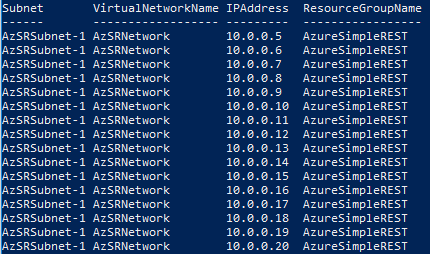Sometimes you just need to know to which Log Analytics Workspace (OMS for the old folks out there) a VM send it’s data to. Or even all of you Azure VMs an once.
With the following script this task is easy as pie. And thanks to RamblingCookieMonster and his PSExcel modul you can send the result straight to everybody who is fond of Excel.
ReportLogAnalyticsWorkspacePerVM.ps1 #region Report: All VMs including the status, and OMS workplace $Subscriptions = Get-AzureRmSubscription | Where-Object { $_.
When searching in Log Analytics, matches regex can be very helpful. By default, the Regular Expression Case is Sensitive. To change this, the parameter i must be passed.
Here is a sample query that searches the IIS logs for logs from a particular computer.
W3CIISLog | where ( Computer matches regex "(?i)MyCoMpUtEr" ) // (?i) = Case insensitive
If you are using Azure Automation and use the AzureRM.Network module in one of the versions from 0.9.0 to min. 0.10.0, you may experience problems running Azure Automation Runbooks.
If the runbooks used are more complex overall, this version may result in a high memory load. If more than 400 MB RAM are used, the runbook ends after three attempts in the status “Suspended”.
Failure The runbook job was attempted 3 times, but it failed each time.
Whether with automated deployment or when creating a load balancer in Azure. Finding a free IP address is unfortunately not an easy task with the existing cmdlets.
Test-AzureRmPrivateIPAddressAvailability
A popular way to archive that is to use the cmdlet Test-AzureRmPrivateIPAddressAvailability. It returns the value TRUE or FALSE when specifying the network and an IP address. Some people now loop through every network address in a subnet until a free IP address is confirmed by TRUE.
Although Microsoft does a great job with their AzureRM Modul module, there are always reasons not to use these cmdlets. In most cases because they are slower than direct requests against the Azure REST API. In other cases because certain functionality has not yet been implemented.
The module AzureSimpleREST written by me positions itself in this gap
The module contains e.g. functions like “Get-AzSRVMProtectionStatus” which uses an officially documented REST Call, but I don’t know any AzureRM cmdlet that provides this function.
Pester tests can be used to ensure a level of quality in PowerShell module development that would otherwise be difficult to achieve manually. There are two important factors to consider. Module and Function Integrity.
Function Integrity I will explore this point in more detail in a later blog entry. In short, the actual function of the module must be ensured.
A popular example is a function that adds up two numbers.




